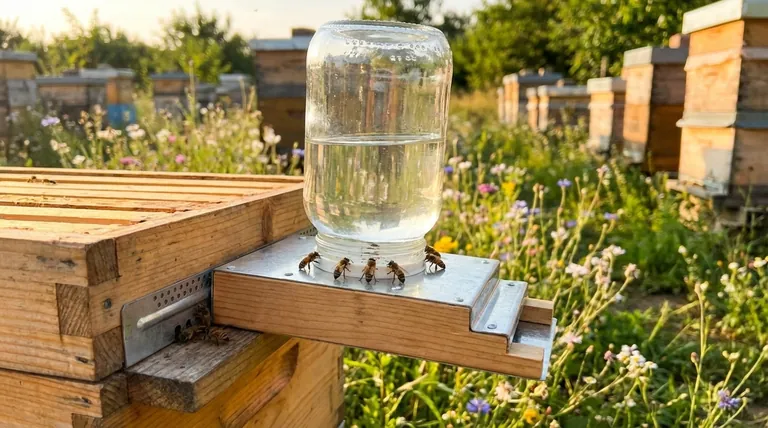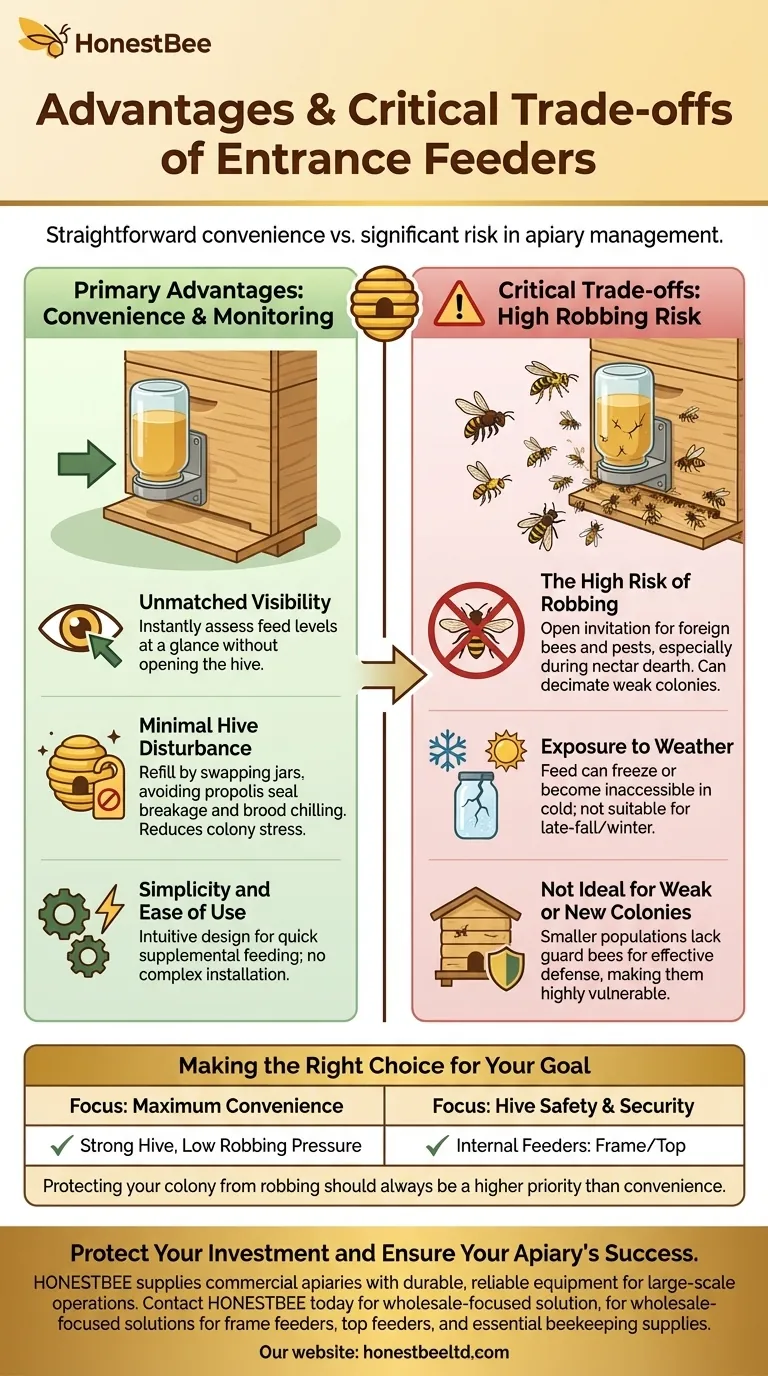When it comes to feeding your bees, an entrance feeder is valued for its straightforward convenience. Its primary advantages are that you can monitor feed levels at a glance and refill the syrup without opening the hive, which minimizes disturbance to the colony.
While entrance feeders offer exceptional ease of use, this convenience must be carefully weighed against a significant risk. Their placement at the hive's front door makes them an open invitation for robbing by other bees and pests, limiting their safe use to very specific conditions.

The Primary Advantages of Entrance Feeders
Entrance feeders, also known as Boardman feeders, consist of a small platform that slides into the hive entrance, holding an inverted jar of sugar syrup. This simple design is the source of their main benefits.
Unmatched Visibility for Monitoring
Because the syrup container sits entirely outside the hive, you can instantly assess how much the bees are consuming.
This constant visibility allows you to know exactly when a refill is needed without ever suiting up or bothering the colony.
Minimal Hive Disturbance
Refilling an entrance feeder is as simple as swapping an empty jar for a full one. You do not need to open the hive lid.
This prevents breaking the bees' propolis seals, avoids chilling the brood nest, and reduces overall stress on the colony, which is a significant benefit for hive health.
Simplicity and Ease of Use
The design is intuitive and requires no complex installation. For a beekeeper needing to provide a quick supplemental feeding, it is one of the fastest methods available.
Understanding the Critical Trade-offs
The greatest strength of the entrance feeder—its accessibility—is also its most critical weakness. Understanding the associated risks is non-negotiable for responsible beekeeping.
The High Risk of Robbing
Placing a source of sugar directly at the hive entrance is like advertising a free meal. The scent of syrup can attract bees from other colonies, as well as wasps and hornets.
This can trigger robbing, where the foreign bees attempt to invade the hive and steal its resources. A robbing event can decimate a weak colony in a matter of hours.
This risk is highest during a nectar dearth—a period when natural forage is scarce and foragers are desperately seeking any available food source.
Exposure to Weather
The external placement of the feed jar means it is directly exposed to the elements.
In cooler temperatures, the syrup can become too cold for the bees to consume. In freezing weather, the entire jar can solidify, rendering it useless and potentially causing the glass to crack. This makes it completely unsuitable for late-fall or winter feeding.
Not Ideal for Weak or New Colonies
A small or newly established colony has a smaller population and may not have the guard bees necessary to defend the entrance effectively.
Using an entrance feeder on a weak hive is exceptionally dangerous, as it puts them at a severe disadvantage if robbing is initiated.
Making the Right Choice for Your Goal
The decision to use an entrance feeder depends entirely on your colony's strength and the current environmental conditions.
- If your primary focus is maximum convenience for a strong hive: An entrance feeder is a viable tool for supplemental feeding during a robust summer nectar flow when robbing pressure is low.
- If your primary focus is hive safety and year-round security: An internal feeder (such as a frame or top feeder) is the superior choice, as it keeps the feed securely inside the hive and away from predators.
Ultimately, protecting your colony from robbing should always be a higher priority than convenience.
Summary Table:
| Advantage | Key Takeaway |
|---|---|
| Easy Monitoring | See feed levels at a glance without opening the hive. |
| Minimal Disturbance | Refill syrup jars without chilling the brood or stressing bees. |
| Simple to Use | Quick setup for fast supplemental feeding. |
| Major Risk | High potential for robbing by other bees and pests. |
Protect Your Investment and Ensure Your Apiary's Success
Choosing the right equipment is critical for hive health and productivity. While entrance feeders have their place, internal feeders are often the safer, more secure choice for protecting your colonies from robbing and the elements.
HONESTBEE supplies commercial apiaries and beekeeping equipment distributors with the durable, reliable supplies needed for large-scale operations. We understand that your bottom line depends on healthy, productive hives.
Let us help you equip your operation for success. Contact HONESTBEE today to discuss our wholesale-focused solutions for frame feeders, top feeders, and other essential beekeeping equipment.
Visual Guide

Related Products
- Boardman Entrance Bee Feeder Durable Galvanized Steel and Wood Construction for Beekeeping
- Classic Boardman Entrance Bee Feeder Hive Front Feeding Solution
- HONESTBEE Entrance Bee Feeder Professional Hive Nutrition Solution for Beekeeping
- HONESTBEE Entrance Bee Feeder Efficient Hive Front Liquid Feeding Solution for Beekeeping
- Professional Hive Front Entrance Bee Feeder
People Also Ask
- How do you make an entrance feeder for bees? A Guide to Safe & Effective Hive Feeding
- What are the different types of feeders available for beehives? A Guide to Entrance, Hive-Top, and Frame Feeders
- How does a bee entrance feeder work? A Simple Guide to Convenient Hive Feeding
- What is an entrance feeder and how is it used? Avoid the Critical Risk of Robbing
- What types of bee feeders are available for beginners? Start with the Simple Entrance Feeder



















